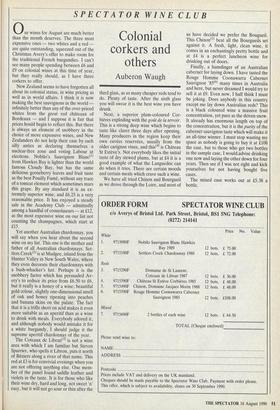SPECTATOR WINE CLUB
Colonial corkers and others
Auberon Waugh
0 ur wines for August are much better than the month deserves. The three most expensive ones — two whites and a red — are quite outstanding, squeezed out of the Christmas Avery's offer to make room for the traditional French burgundies. I can't see many people spending between 16 and £9 on colonial wines at this time of year, but they really should, as I have three corkers to offer.
New Zealand seems to have forgotten all about its colonial status, in wine pricing as well as in world affairs. I think it is now making the best sauvignons in the world — infinitely better than any of the over-priced whites from the great red châteaux of Bordeaux — and I suppose it is fair that prices hould begin to reflect this. But there is always an element of snobbery in the choice of more expensive wines, and New Zealanders do not help their case by such silly antics as declaring themselves a nuclear-free zone and voting Labour at elections. Nobilo's Sauvignon Blanc") from Hawkes Bay is lighter than the world famous Cloudy Bay, but has the same delicious gooseberry leaves and fruit taste as the best Pouilly Fume, without any trace of a tomcat element which sometimes mars this grape. By any standard it is an ex- tremely superior wine, and £6.25 is a very reasonable price. It has enjoyed a steady sale in the Academy Club — admittedly among a handful of connoisseurs — at £12, as the most expensive wine on our list not counting the champagnes, which start at £15.
Yet another Australian chardonnay, you will say when you hear about the second wine on my list. This one is the mother and father of all Australian chardonnays. Set- tlers Creek(2) is at Mudgee, inland from the Hunter Valley in New South Wales, where they even decorate their chardonnays with a bush-whacker's hat. Perhaps it is the snobbery factor which has persuaded Av- ery's to reduce its price from £6.50 to £6, but it really is a honey of a wine; beautiful gold colour, slightly one-dimensional smell of oak and honey ripening into peaches and banana skins on the palate. The fact that it is a trifle short on acid makes it even more suitable as an aperitif than as a wine to drink with meals. Everybody adored it, and although nobody would mistake it for a white burgundy, I should judge it the supreme aperitif chardonnay of the year. The Coteaux de Libran(3) is not a wine area with which I am familiar but Steven Spurrier, who spells it Libron, puts it north of Beziers along a river of that name. This red at £3 is for convivial evenings when you are not offering anything else. One mem- ber of the panel found saddle leather and violets in the taste. It is for those who like their wine dry, hard and long, not sweet 'n' easy, but it will not go sour or thin after the
third glass, as so many cheaper reds tend to do. Plenty of taste. After the sixth glass you will swear it is the best wine you have drunk.
Next, a superior plum-coloured Cor- bieres exploding with the goat de la terroir. This is a strong deep wine which begins to taste like claret three days after opening. Many producers in the region keep their own cuvees reservees, usually from the older carignan vines, and this(4) is Château St Esteve's. Not everybody likes the initial taste of dry stewed plums, but at £4 it is a good example of what the Languedoc can do when it tries. There are certain moods and certain meals which crave such a wine.
We have all tried Chinon and Bourgueil as we drove through the Loire, and most of
us have decided we prefer the Bougueil. This Chinon(5) beat all the Bourgueils set against it. A fresh, light, clean wine, it comes in an enchantingly pretty bottle and at £4 is a perfect luncheon wine for drinking out of doors.
Finally, a humdinger of an Australian cabernet for laying down. I have tasted the Rouge Homme Coonawarra Cabernet Sauvignon '85(6) many times in Australia and here, but never dreamed I would try to sell it at £9. Even now, I half think I must be joking. Does anybody in this country except me lay down Australian reds? This is a black coloured wine a massive fruit concentration, yet pure as the driven snow. It already has enormous length on top of the concentration, but it is the purity of the cabernet sauvignon taste which will make it an all-time winner. I must stop wasting my space as nobody is going to buy it at £108 the case, but to those who get two bottles in the sample case, I would.advise drinking one now and laying the other down for four years. Then see if I was not right and kick yourselves for not having bought five cases.
The mixed case works out at £5.38 a bottle.


























































 Previous page
Previous page